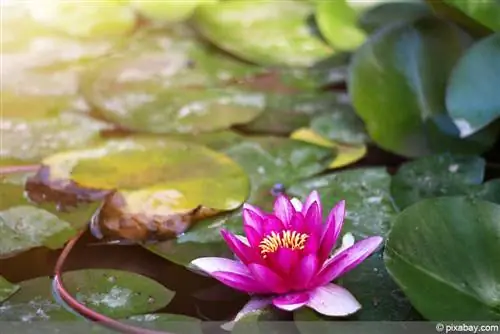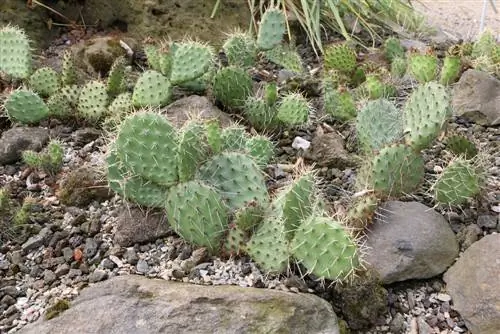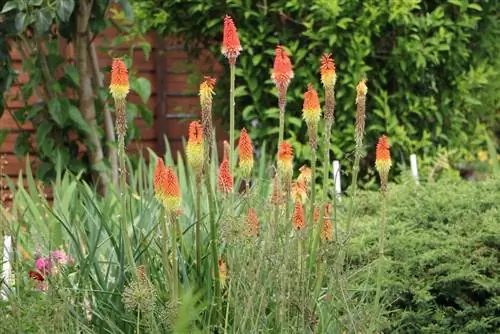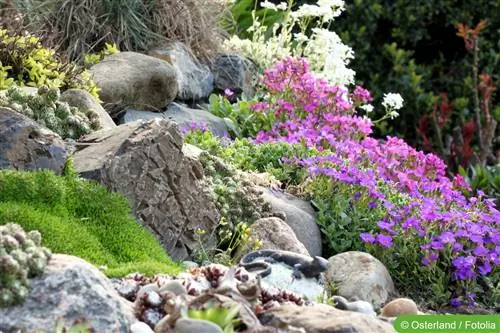- Author admin [email protected].
- Public 2023-12-17 03:39.
- Last modified 2025-01-24 12:45.
Furthermore, it can be cut off for shaping or radically cut. In winter it should be protected with brushwood and fleece. Another plus point is its robustness against pests and diseases. Since it is not poisonous, it is also often used as a medicinal plant. It should be lightly fertilized in spring.
Frequently asked questions about rock garden plants
How can pests in the rock garden be effectively controlled?
Unfortunately, harmful insects can also be found in the rock garden. Slugs and aphids are particularly common in this area. If the insects are of the cell sap-sucking variety, predators such as predatory bugs, lacewing larvae or ladybirds can be used. Another very effective method of combating pests is to regularly water the rock garden with a decoction of field horsetails or stinging nettles. However, this method is only used for prevention. However, when faced with a snail infestation, you have to be persistent. Snail traps are suitable here. The snails should be collected early in the morning or at dusk. Introducing lizards or hedgehogs can also be effective, as they prefer to eat snails.
Can medicinal or useful plants also be cultivated in the rock garden?
Mediterranean crops can also be planted in the rock garden. For example, the rock garden can also be used for thyme, rosemary or lavender. The hillside location of the rock garden is particularly recommended, as this allows excess water to drain away easily. A location in full sun is ideal.
Do the seeds of rock garden plants have to be grown indoors?
It is better if the seeds are grown indoors, because if the seeds are simply scattered in the rock garden, a harmonious design can of course no longer be achieved. Not only do plants sprout everywhere, but you also quickly lose track. The pre-grown rock garden plants can be planted specifically in the desired location.
What should you pay special attention to when handling spurge?
As already mentioned, the sap of spurge is poisonous. You should therefore definitely wear gloves when carrying out any cutting work, as the juice comes out even with very small cuts. Allergy sufferers should be even more careful here. In addition, spurge is dangerous for children and pets such as guinea pigs, birds, dogs, cats, hamsters and rabbits.
What you need to know about rock garden plants
Rock garden plants for a sunny spot
- The upholstery or carpet phlox grows to a height of around 10 to 15 cm and blooms from April to May. There are now many varieties on the market that produce white, pink, red or blue flowers. Phlox grows very quickly and, as the name suggests, forms a carpet. It is therefore also well suited as a ground cover that can cover an area of up to half a square meter within two to three years. It likes it sunny and should be fertilized in spring.
- The prickly nut or acaena can also be used as a ground cover. It grows very quickly and forms cushions. Depending on the variety, this plant grows from ten centimeters to about half a meter high and produces round, spiky, very decorative inflorescences in July or August. The color of the leaves ranges from blue-grey to blue-green and copper-brown to dark green and red.
Evergreen plants that like shade
- The ornamental grass forest ledge has broad foliage in a light green color and can also be easily planted under bushes or trees. It grows up to one meter high and is very easy to care for. From May to August, yellowish-white spires form that grow above the grass. The leaves of the variegated variety turn yellow in winter, adding a splash of color to the garden.
- There are many species of saxifrage that are evergreen. It got its name because in its natural environment it grows primarily in rock crevices and it was previously assumed that the plant could actually break a stone. That is why it was also administered in medicine to patients with kidney, bladder or gallstones. The moss saxifrage species like shade or partial shade and bloom there abundantly from May to June with many small flowers.






